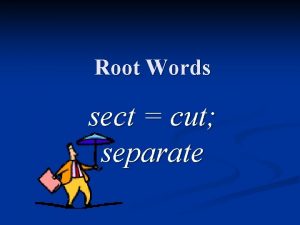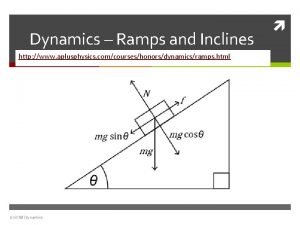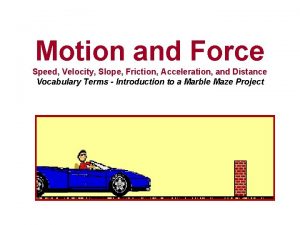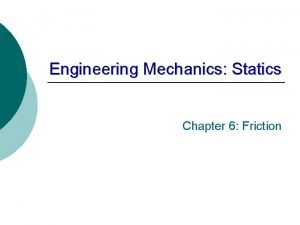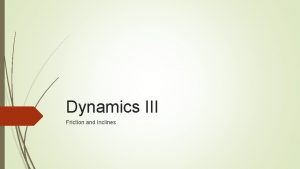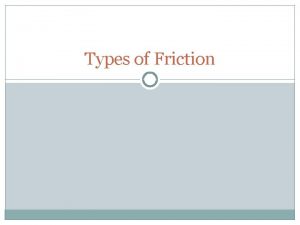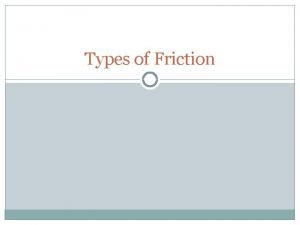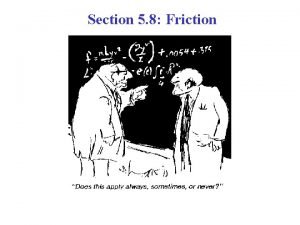Sect 4 8 Friction Inclines Friction Friction is













- Slides: 13

Sect. 4 -8: Friction & Inclines

Friction • Friction is always present when 2 solid surfaces slide along each other. – We must account for it to be realistic! – Exists between any 2 sliding surfaces. – There are two types of friction: Static (no motion) friction Kinetic (motion) friction – The size of the friction force depends on the microscopic details of 2 sliding surfaces. These details aren’t fully understood & depend on • • The materials they are made of Are the surfaces smooth or rough? Are they wet or dry? Etc. , etc.

• Kinetic Friction is the same as sliding friction. Experiments determine the relation used to calculate friction force. • The kinetic friction force Ffr is proportional to the magnitude of the normal force FN between 2 sliding surfaces. The DIRECTIONS of Ffr & FN are each other!! Ffr FN • We write their relation as Ffr k. FN (magnitudes) k Coefficient of Kinetic Friction k depends on the surfaces & their conditions, is dimensionless & < 1 It is different for each pair of sliding surfaces.

• Static Friction: A friction force Ffr exists || 2 surfaces, even if there is no motion. Applies when 2 surfaces are at rest with respect to each other. The static friction force is as big as it needs to be to prevent slipping, up to a maximum value. Usually it is easier to keep an object sliding than it is to get it started. Consider an applied force FA: ∑F = ma = 0 & also v = 0 There must be a friction force Ffr to oppose FA – Ffr = 0 or Ffr = FA

• Experiments find that the maximum static friction force Ffr (max) is proportional to the magnitude (size) of the normal force FN between the 2 surfaces. The DIRECTIONS of Ffr & FN are each other!! Ffr FN • Write the relation as Ffr (max) = s. FN (magnitudes) s Coefficient of static friction – Depends on the surfaces & their conditions – Dimensionless & < 1 – Always find s > k Static friction force: Ffr s. FN

Coefficients of Friction μs > μk Ffr (max, static) > Ffr (kinetic)

Static & Kinetic Friction

Example 4 -16: Friction; Static & Kinetic A box, mass m =10. 0 -kg rests on a horizontal floor. The coefficient of static friction is s = 0. 4; the coefficient of kinetic friction is k = 0. 3. Calculate the friction force on the box for a horizontal external applied force of magnitude: (a) 0, (b) 10 N, (c) 20 N, (d) 38 N, (e) 40 N.

Conceptual Example 4 -17 You can hold a box against a rough wall & prevent it from slipping down by pressing hard horizontally. How does the application of a horizontal force keep an object from moving vertically?

Example 4 -19: Pulling against friction A box, mass m = 10 kg, is pulled along a horizontal surface by a force of FP = 40. 0 N applied at a 30. 0° angle above horizontal. The coefficient of kinetic friction is k = 0. 3. Calculate the acceleration.

Conceptual Example 4 -18: To push or to pull a sled? Your little sister wants a ride on her sled. If you are on flat ground, will you exert less force if you push her or pull her? Assume the same angle θ in each case. Pushing y forces: ∑Fy = 0 FN – mg –Fy = 0 FN = mg + Fy Ffr (max) = μs. FN x forces: ∑Fx = ma ∑F = ma Pulling y forces: ∑Fy = 0 FN - mg + Fy = 0 FN = mg - Fy Ffr (max) = μs. FN x forces: ∑Fx = ma

Example 4 -20: Two boxes and a pulley 2 boxes are connected by a cord running over a pulley. The coefficient of kinetic friction between box A & the table is 0. 2. Ignore mass of cord & pulley & friction in the pulley, which means a force applied to one end of the cord has the same magnitude at the other end. Find the acceleration, a, of the system, which has the same magnitude for both boxes if the cord doesn’t stretch. As box B moves down, box A moves to the right. ∑F = ma For EACH mass separately! x & y components plus Ffr = μk. FN a a

a FN 2 FN 1 Problem 48 F 21 FA = F 12 Ffr 1 m 1 g m 1: ∑F = m 1 a; Ffr 2 m 2 g x: FA – F 21 – Ffr 1 = m 1 a y: FN 1 – m 1 g = 0 m 2: ∑F = m 1 a; x: F 12 – Ffr 2 = m 2 a y: FN 2 – m 2 g = 0 Friction: Ffr 1 = μk. FN 1; Ffr 2 = μk. FN 2 3 rd Law: F 21 = - F 12 m 1 = 75 kg m 2 = 110 kg a = 1. 88 m/s 2 F 12 = 368. 5 N
 Sect root word
Sect root word Difference between ethics and legality
Difference between ethics and legality Politeísm
Politeísm Galileo found for steeper inclines
Galileo found for steeper inclines Dynamics ramps and inclines
Dynamics ramps and inclines Low and high friction
Low and high friction Friction
Friction Pericardial friction
Pericardial friction Sliding friction
Sliding friction Friction transforms mechanical energy to
Friction transforms mechanical energy to Friction force
Friction force Engineering mechanics (9th) edition chapter 12 problem 30p
Engineering mechanics (9th) edition chapter 12 problem 30p Bill nye electricity worksheet
Bill nye electricity worksheet Whenever there is too little friction or traction
Whenever there is too little friction or traction
